Abstract
To describe the skid resistance attenuation of asphalt pavement during its life cycle, this paper selected a multi-variable accelerated abrasion machine to simulate the abrasion process, and British Pendulum Number was selected to evaluate the skid resistance after various abrasive cycles. During the abrasion process, three factors influencing the skid resistance were considered, including aggregate types (diorite, limestone, granite, and basalt), nominal maximum aggregate size (NMAS), and gradations (dense, gap, and open). The results show that with increasing abrasion cycles, the skid resistance of asphalt pavement firstly decreases rapidly in the first abrasion stage (0–8000 cycles), then at a relatively gentle rate in the second abrasion stage (8000–20,000 cycles), and finally at the lowest rate in the third abrasion stage (after 20,000 cycles). The skid-resistance durability and stability of pavement are ranked as basalt > granite > amphibolite > limestone. Moreover, the effect of aggregate parameters on skid resistance is in the order: angularity > PSV > WSV > CSV. The skid resistance and its stability improve as NMAS increases. The pavement skid durability is in the order: SMA > OGFC > AC. In addition, the sizes of 16 mm, 13.2 mm, 9.5 mm, 0.6 mm, 0.3 mm and 0.15 mm are the critical sieve sizes to improve the skid resistance of asphalt pavement.
1. Introduction
As is widely recognized, the skid resistance of pavement is a crucial indicator that impacts road traffic safety. However, with the increasing service life of pavement, its skid resistance inevitably deteriorates to varying degrees. This not only seriously compromises the safety and driving comfort of roads but also significantly escalates road maintenance costs and shortens their service life. Previous research [1] shows that a low friction coefficient of pavement poses a hidden danger to road traffic safety and heightens the likelihood of traffic accidents, especially in inclement weather conditions such as rain or snow. Therefore, studying the anti-skid characteristics of pavement has profound social significance and value for ensuring “safe transportation and green travel.”
There are various methods for the laboratory simulation of asphalt pavement skid resistance. An aggregate-and-asphalt mixture friction characteristics tester [2] is a small, straight, road wear instrument that is jointly developed by the China Merchants Chongqing Transportation Research and Design Institute and Chongqing Jiaotong University. It uses the sliding friction between a rubber slider and the asphalt slab to simulate the frictional action between tires and a road surface. The South China University of Technology [3,4] develops a tire-driven pavement functional accelerated-loading test system, and the motion track of the tire in it is circular. The accelerated loading instrument based on an indoor large and straight track developed by the Changsha University of Technology is a typical full-scale test [5]. This method simulates field abrasion by contact between the rolling tire and the pavement. Thus, this indoor test is an effective method for investigating the skid resistance of asphalt pavement.
The factors affecting the skid resistance of asphalt pavement are mainly its micro- and macro-texture. The micro-texture is mainly determined by the aggregate properties, which have a great influence on the friction of the road surface. It has been reported that pavements with high polish value aggregates have great skid resistance [6,7]. Simultaneously, the hardness and wear of the aggregate also have an impact on the asphalt pavement’s skid resistance [8,9]. Moreover, the shape characteristics and angularity of the aggregates also play a role in the skid resistance of asphalt pavement. Shah [10] has found that an asphalt mixture with higher-angularity aggregates shows better skid resistance and stability. Sengoz [11] et al. selected basalt and limestone with different crushing methods to study the influence of aggregates by incorporating different shapes and types into the texture of the asphalt pavement. The results show that basalt is more angular than limestone, and the aggregates that are sharp and angular can contribute to a rich texture for asphalt pavement. In order to investigate the contribution of aggregates incorporating different shapes and angularity into their texture, Bessa [12] selected granite, gneiss, and phonolite from different quarries as research objects. For aggregates with the same crushing method, there is little difference in their shape and angularity, but there is a difference in their mixture surface texture. This is mainly because the shape and angularity of the aggregate are mainly related to the crushing method, while the surface texture mainly depends on the lithology of the aggregates.
For the controllable factors of asphalt pavement design, the main reasons affecting skid resistance include: aggregate properties, aggregate gradation, the mixture design method, and the application of higher asphalt content than the optimum asphalt content (OAC) [13]. It has been reported that the aggregate properties have little correlation with the macro-texture of the mixtures, while aggregate gradation and pavement quality are critical for macro-texture [14]. One study investigated the friction properties of different mixes, including their dense gradation and gap gradation. The mean profile depth (MPD) was selected to evaluate the macro-texture. The results show that the mixes incorporating different gradations have similar micro-texture but significantly different macro-textures, and the orders of the macro-textures are as follows: open-graded mixtures > gap-graded mixtures > dense-graded mixtures [15]. Additionally, traffic volumes and environmental conditions also had an impact on the skid resistance of the pavement [16,17]. The British Pendulum Number (BPN) was selected to investigate the skid resistance of a wide range of mixtures. Multiple variables were considered, including mix type, mix design method, asphalt content, and aggregate type. The results showed that a mix incorporating 30% steel slag had the best skid resistance, and the BPN of the Superpave mixture was higher than that of stone matrix asphalt (SMA). Simultaneously, as the asphalt content is higher than OAC, the skid resistance decreased [18].
Although many studies have been carried out on skid resistance, these studies have focused on the sensitivity of skid resistance to influencing factors without abrasion. Many influencing factors were considered, including aggregate type, aggregate properties, aggregate gradation, mix type, mix design method, and so on. Although field research is the most direct and effective way to study skid resistance, there are many factors that affect the field skid resistance of asphalt pavement, including traffic volume, environmental conditions, aggregate types, construction levels, and so on. It is difficult to grasp the long-term effects of materials on the skid resistance of pavement under the same external conditions.
This paper aims to investigate the laboratory skid resistance of asphalt pavement throughout its life cycle using an accelerated abrasion machine to simulate the abrasion process. The abrasion process was considered to have ended when the number of abrasive cycles reached 24,000. This study considers the effects of aggregate types, nominal maximum aggregate size (NMAS), and gradation types on skid resistance during the abrasion process. When the influencing factors of skid resistance changed, the other design parameters of mixtures remained unchanged. The changes in the BPN of the specimens after every 2000 abrasive cycles were used to evaluate the attenuation of skid resistance. The paper’s outline is shown in Figure 1.
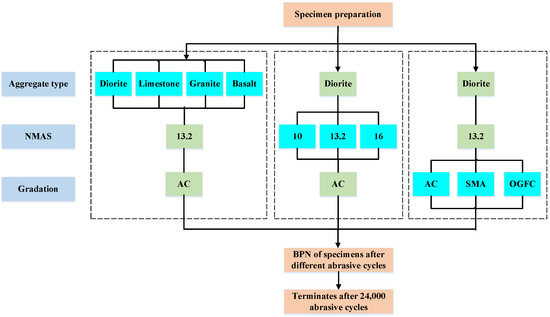
Figure 1.
Test outline in this paper.
2. Materials and Methods
2.1. Text Materials
2.1.1. Asphalt
The binder used was China Zhonghai 90# virgin asphalt and styrene–butadiene–styrene (SBS)-modified asphalt. Their physical properties are shown in Table 1.

Table 1.
Physical properties of used asphalt.
2.1.2. Aggregate
The aggregates used in this paper must meet the technical requirements [19,20]. Four types of aggregates were selected, including diorite, limestone, granite, and basalt. The aggregates with various minerals and chemical compositions have different physical and chemical properties, resulting in different surface textures. Simultaneously, the mechanical properties of aggregates are a direct reflection of their mineral and chemical compositions. Therefore, the mechanical properties of the four kinds of aggregates were investigated, and the results are shown in Table 2 and Table 3.

Table 2.
Physical properties of used coarse aggregates.

Table 3.
Physical properties of used fine aggregates.
2.2. Mixture Design
The surface texture of asphalt mixes of different types varies considerably, resulting in large differences in the skid resistance. Three types of asphalt mixtures were selected for subsequent study in this paper, namely dense asphalt mixture (recorded as AC), SMA, and open-graded friction course (OGFC). The different gradation mixture types are the median values of the corresponding specification [19] gradation range. The types of mixtures used in the paper are summarized in Table 4.

Table 4.
Gradations for various asphalt mixtures used.
2.3. Test Equipment
2.3.1. Accelerated Abrasion Machines
The multi-variable accelerated abrasion machine (MAAM) [21,22] is shown in Figure 2, developed by the Highway and Airport Pavement Research Center of Chang’an University, was selected to simulate the abrasion process of asphalt pavement. The MAAM drives the tire to reciprocate along two tracks through the circular movement of the crank arm. When the tire moves to the left side and the displacement sensor is recognized, the cylinder applies air pressure to the tire. Subsequently, the tire is lifted and moved to the right side without contacting the testing specimen. When the tire returns to the right side and is recognized by the displacement sensor, the cylinder releases air pressure. Then, the tire lands and wears on the testing specimen under the push of the crank arm until it moves to the left sides and lifts again. The process in which the road surface is worn once and the tires return to the starting point is recorded as a cycle.
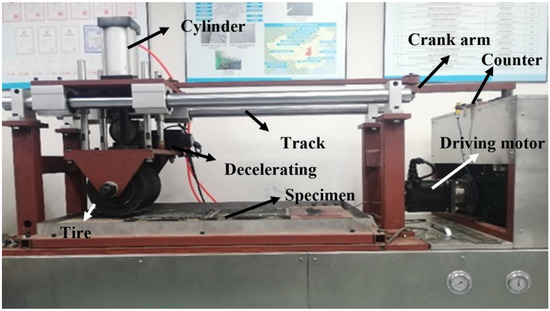
Figure 2.
Multiple-accelerated abrasion machine [21].
In terms of work efficiency, the MAAM should run as fast as possible to accelerate specimen abrasion. However, the MAAM is limited by factors such as air pump conditions, equipment stability, and abrasion effects under actual operating conditions. After several debugs, the setting parameters for MAAM are shown in Table 5.

Table 5.
The setting parameters for MAAM.
2.3.2. Skid Resistance Evaluation
BPN was used to evaluate the skid resistance, and the asphalt pavement surface should be wet during testing. More operational details refer to Chinese standards [23].
2.4. Test Program Design
2.4.1. Specimen Preparation
The width of the tire in MAAM is 24.5 cm, which is slightly larger than the actual contact area between the field wheels and the pavement surface. Due to the edge effect, the data collected from the edge of the specimen within 5~10 cm were not representative. Therefore, test molds with a size of 50 cm × 50 cm × 5 cm were selected.
The quality of the mixtures required for the test molds (50 cm × 50 cm × 5 cm) is approximately 3 times that for a normal rutting slab (30 cm × 30 cm × 5 cm). Due to the limited production of the mixing pot, the asphalt mixtures were mixed three times. The mixed mixtures needed to be kept warm in an oven at 170 °C for 30 min.
The test mold was placed into the pre-cut cement tank to facilitate a walk-behind single roller to run. Depending on the principle of first, middle, and then around, the mixtures were loaded into the test mold in batches. The compaction temperature was not lower than 155 °C, and the number of compaction was 25 cycles. After the roller rolled over the specimen, it returned to the starting point. The entire process was recorded as a cycle. In the compaction process, there were 8 static compaction cycles first, followed by 9 vibratory compaction cycles, and finally, 8 compaction cycles. In addition, the specimen must be placed at room temperature for not less than 24 h before demolding. There were two specimens prepared for each test.
2.4.2. Influencing Factors
Three factors influencing the skid resistance were considered, including aggregate types, NMAS, and gradations. Their factor levels were four, three, and three, respectively. The details are given in Table 6.

Table 6.
Influencing factors and their levels.
2.4.3. Test Locations’ Distribution and Selection
Five test locations in the formed pavement slab were tested for skid resistance, as shown in Figure 3. The area of each test position was 104 mm × 72 mm. Five replicated BPN measurements were performed at each location, with three replicated BPN measurements taken in the center of each test location. The remaining two test areas overlapped with approximately 1/2 the rubber block area in the pendulum friction tester in both the up and down directions along the short edge.
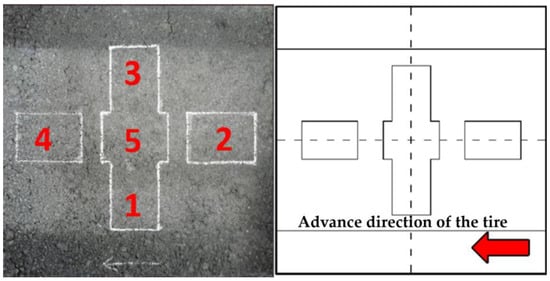
Figure 3.
Illustration of abrasion test location.
Three kinds of mixtures were used to measure skid resistance attenuation, namely AC13, SMA13, and OGFC13. The decay rate (DR) of BPN was utilized as an evaluation index, which represented the percentage of the change value to the initial value (IV). After wearing for 6000 cycles, 12,000 cycles, and 18,000 cycles, DR in different test locations for various mixtures could be calculated by Equation (1). The results are shown in Table 7.
where α is the DR; R0 refers to the initial value of BPN without abrasion; and Rt is the BPN under cycles of abrasion.

Table 7.
DR in different test locations for various mixtures.
From Table 6, it can be drawn that the three types of asphalt slab (AC13, SMA13, and OGFC13) generally have the lowest DR in the abrasion process at locations No. 2 and 4. This is because locations No. 2 and No. 4 are located in the areas where the tire lands and is lifted. Part of the time is spent applying loads or reducing loads for the tire, resulting in a lower abrasion net time than other test locations. Moreover, these two test locations were subjected to accelerations or decelerations for the tire, so the contacting conditions were not completely consistent with the field state when the vehicle drives smoothly.
For other test locations, although the net wear time is the same, there are significant differences in the abrasion effects. The DR of BPN in locations No. 1 and No. 3 are lower than that in No. 5. Because No. 1 and No. 3 are located on the outside of the wear area of the specimen, there may be a condition without incomplete abrasion due to possible deviations in the position of the specimen placed each time. By contrast, No. 5 is located in the middle of the specimens. The specimens can be completely worn regardless of whether it is placed with a deviation, and the abrasion effect is significant. Therefore, No. 5 was chosen as the datum point of test locations.
2.4.4. Determination of the Final Number of Abrasions
Figure 4 shows the BPN of AC-13 and SMA-13 with various abrasive cycles. After 20,000 abrasive cycles, the BPN tends to be stable, and the attenuation rate is very low. However, it is difficult to decide whether continued abrasions have a significant effect just by the changed value.

Figure 4.
The BPN of AC-13 and SMA-13 with various abrasive cycles.
A t-test at 95% confidence intervals was performed on the BPN of AC-13 and SMA-13 from 20,000 to 24,000 abrasive cycles. The results are shown in Table 8. Simultaneously, a t-test at a 95% confidence interval was also performed on the BPN of AC-13 and SMA-13 from 24,000 to 30,000 abrasive cycles. The results are shown in Table 9.

Table 8.
T-test of BPN from 20,000 to 24,000 abrasive cycles.

Table 9.
T-test of BPN from 24,000 to 30,000 abrasive cycles.
When the number of abrasive cycles is less than 20,000, the BPN decay is greater than 1 as the abrasion increases for 2000 cycles. However, the BPN decreases by less than 1 for another 2000 cycles after 20,000 cycles. This indicates that the BPN changes slowly after 20,000 abrasive cycles. With increasing abrasive cycles from 20.000 to 24,000, the statistical analysis t-values of BPN for AC-13 and SMA-13 are 3.62 and 4.792, respectively, which are more than the critical value of 2.776 at the 95% confidence intervals. Meanwhile, the statistical analysis p-values are less than the critical value of 0.05. This indicates that the BPN change is significant from 20,000 to 24,000 abrasive cycles. On the contrary, the statistical analysis t-values of BPN from 24,000 to 30,000 abrasions are less than the critical value, while the statistical analysis p-values are more than the critical value. It can be concluded that after 24,000 abrasive cycles, BPN has little change in statistics with continuous abrasions. Therefore, when the number of abrasions reached 24,000 cycles, the abrasive test was terminated.
2.4.5. Grey Relational Analysis of Influencing Factors
Grey systems theory proposes a new analytical approach, namely grey relational analysis (GRA), which is a multi-factor statistical analysis method. GRA aims to establish a gray correlation matrix and calculate the gray correlation coefficient (GCC) [24,25,26,27]. GRA was used to determine the ranking of influencing factors on skid resistance in this paper. There were three skid-resistance indexes used for this analysis, namely the initial value of BPN (recorded as IV), the terminal value of BPN (recorded as TV), the attenuation value (the difference between IV and TV, recorded as AV), and the DR.
In order to qualitatively analyze the influence of aggregate types on the skid resistance, the GRA between the mechanical properties (PSV, WSV, CSV, and angularity) of four kinds of aggregates (diorite, limestone, granite, and basalt) and the skid-resistance indexes (IV, TV, AV, and DR) were established, and the influencing factors were ranked by GCC.
To make the analysis results more representative, six mixtures were selected to evaluate the effect of gradations on the skid resistance, including AC-13, AC-16, SMA-13, SMA-16, OGFC-13, and OGFC-16. For each kind of mixture, the passing percentage for each sieve size was selected as a parameter. Then, the GRA between the percent of pass for sieve sizes and the skid-resistance indexes were established. The GCC was the average of all kinds of mixtures.
3. Results and Discussion
3.1. Effect of Aggregate Type
When the aggregate types were varied, the AC-13 was used to analyze BPN and its DR after different abrasive cycles. More detail of the mixtures is drawn in Table 5. There were four kinds of asphalt aggregate, namely diorite, limestone, granite, and basalt. The variations in the skid resistance of each pavement specimen versus the number of abrasions are shown in Figure 5.
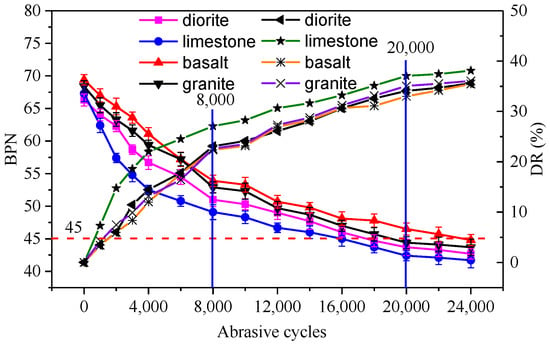
Figure 5.
BPN and its DR of asphalt pavement with different aggregate types.
It can be seen that the BPN of AC-13 incorporating various aggregate types decreases overall, and DR varies from 35.45% and 38.10%. Although there is no significant difference in value, the rate of BPN decreasing varies significantly during abrasion. There are three stages of development for BPN attenuation. When abrasive cycles are less than 8000, BPN decreases the fastest. The DR of specimens with different aggregate types varies from 22.35% to 27.08%, which is more than 60% of the terminal DR. In this stage, the convex edges and corners, being higher than the average surface of the specimens, are easily worn out, resulting in a maximum decreasing rate of BPN. The number of abrasions from 8000 to 20,000 is regarded as the second stage. It may be that the surface texture of the coarse aggregates is worn out in this period, so the reduction rate of BPN is relatively low. With further continuation, it may occur that the surface texture of the fine aggregates is worn out, resulting in a minimum decreased rate of BPN.
BPN IV of specimens with various aggregate types is in the order basalt > granite > limestone > diorite, while the BPN TV numbers are in the order basalt > granite > diorite > limestone. It is obvious that a high BPN IV does not mean a high BPN TV, such as in the case of limestone. The aggregate surface textures are the critical factor for skid resistance for the IV, and the aggregate properties have a great influence on the TV. PSV characterizes the abrasion resistance of the aggregates, which has a critical influence on the skid-resistance durability of its mixtures. The DR results confirm this viewpoint. Specimens with basalt having a maximum PSV have a minimum DR after 24,000 abrasive cycles. On the contrary, the limestone has minimum PSV, resulting in the maximum DR of its mixtures after 24,000 abrasive cycles. This means that PSV is an important indicator of skid resistance.
A BPN of 45 is a critical point. As the pavement BPN becomes less than 45, the skid resistance of the pavement can no longer meet the design requirements, and maintenance is required. Specimens with limestone are the first to fail in terms of BPN at around 16,000 abrasive cycles, and the specimens with basalt last until the skid resistance fails near 24,000 cycles. The skid-resistance durability and stability of pavement are ranked as basalt > granite > amphibolite > limestone.
3.2. Effect of NMAS
Dense asphalt mixtures were selected to analyze the effect of NMAS on its skid resistance. NMAS varied from 10 to 16. The BPN and the DR of asphalt pavement with various NMAS are shown in Figure 6.
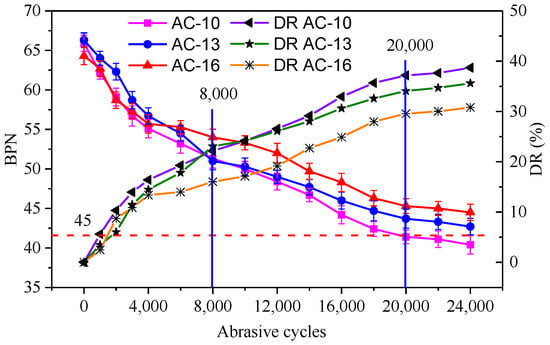
Figure 6.
BPN and DR of asphalt pavement with various NMAS.
With the increase in the number of abrasions, the skid resistance of specimens with different NMAS decrease. The influence curve of NMAS on BPN is similar to that of aggregate types on BPN. The skid resistance of asphalt pavement decreases rapidly in the initial abrasion stage (0–8000 cycles). The skid resistance decreases at a relatively gentle rate in the subsequent abrasion stage (8000–20,000 cycles), and there is no significant difference in the skid resistance in the third abrasion stage (after 20,000 cycles).
Although there is no significant difference in BPN IV, BPN TV is obviously different. There are many factors that affect the BPN IV, including asphalt film thickness, aggregate properties, NMAS, specimen forming method, etc. When abrasive cycles are less than 6000, there is no significant difference in the skid resistance of specimens with different NMAS. However, the skid resistance of specimens with different NMAS changes significantly with continuous abrasion after 6000 abrasive cycles. This may be due to the fact that the asphalt film was first worn off. The asphalt used in the three mixture types is the same, so there is no significant difference in asphalt film thickness among them, resulting in a slight change in skid resistance. The aggregates are preferentially worn out with further abrasion. It is obvious that specimens with highly coarse aggregates have a richer surface texture and are more difficult to wear out. The AC-16 has the largest BPN TV and the smallest DR. In contrast, the AC-10 has the smallest BPN TV and the largest DR. This indicates that the skid resistance and its stability become better as NMAS increases.
3.3. Effect of Gradation Types
Three kinds of mixtures were used to investigate the effect of gradation on skid resistance, namely AC-13, SMA-13, and OGFC-13. The aggregate type and NMAS of these mixtures are the same. The BPN and the DR of specimens with different gradations are shown in Figure 7.
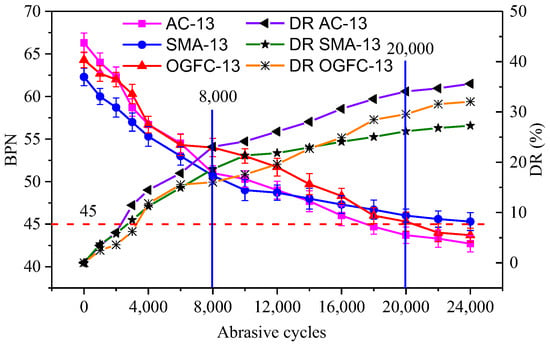
Figure 7.
BPN and DR of specimens with different gradations.
The variation curve of skid resistance under different gradations is the same as that of skid resistance under different aggregate types and different NMAS. The skid resistance first decreases rapidly (0–8000 cycles), then (8000–8000 cycles) at a relatively slow rate, and finally, there is no significant change (after 20,000 cycles). Although SMA pavements have the worst initial skid resistance, they have the best skid resistance at the end of abrasion. On the contrary, AC pavements have the best initial skid resistance but the worst skid resistance at the end of abrasion. This may be because there are significant differences in the OAC of asphalt mixtures with different gradations, which means different asphalt film thicknesses. SMA-13 containing the maximum OAC has the thickest asphalt film, resulting in the lowest BPN IV. As mentioned before, the content of coarse aggregates has a significant effect on the BPN TV. Among the three mixtures, SMA-13 has the highest coarse aggregate content, resulting in the richest surface texture. When the aggregate type is consistent, the BPN TV of mixtures containing higher coarse aggregate content is higher. As the number of abrasions increases, the skid resistance of AC pavement is the first to fail, followed by OGFC pavement and SMA pavement. Therefore, the pavement skid durability is ranked as SMA > OGFC > AC.
3.4. GRA of Influencing Factors
3.4.1. Aggregate Type
The physical properties are obviously different with different lithologies, diagenesis mechanisms, original cross-sectional structures, and crushing forms. Even the same type of aggregate from different places can also be different. Therefore, it is unreasonable to judge the advantages and disadvantages of various aggregates only from the change in the value of skid resistance. The influence of the physical and mechanical properties of the aggregates on the skid resistance of asphalt pavement also needs to be investigated. Four parameters in terms of aggregate properties were considered, including PSV, CSV, WSV, and angularity. The GRA between the IV, DR, AV, TV, and aggregate parameters were established based on the abrasion process and used to investigate the influence of aggregate properties on skid resistance.
From Figure 8, it can be seen that the GCC of angularity for all skid resistance indicators is at its maximum. This indicates that angularity has the greatest impact on the BPN among all aggregate parameters. It may be mainly because the BPN is usually used to evaluate skid resistance at low speeds, while the micro-mixture of asphalt pavement contributes the most to the skid resistance at low speeds. Angularity characterizes the properties of fine aggregates, having a great influence on the micro-texture of asphalt pavement. For the three skid-resistance indicators IV, TV, and AV, the order of the influence of the four aggregate parameters on them is consistent, namely angularity > PSV > WSV > CSV. It can be concluded that a pavement with high angularity and PSV has a rich surface texture, resulting in high skid resistance. Moreover, the GCC between DR and the four aggregate parameters varies from 0.531 to 0.61. This means that there is no significant difference in the impact of these four aggregate parameters on the DR.
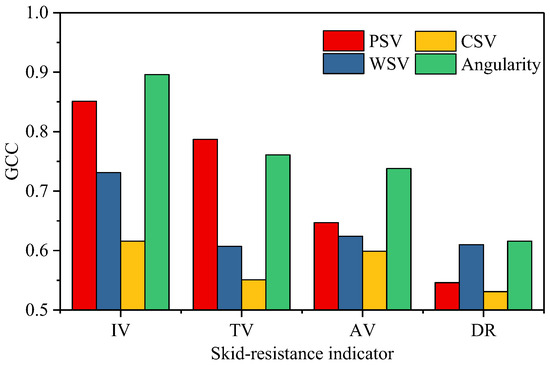
Figure 8.
GCC between aggregate properties and skid-resistance indicators.
3.4.2. Gradation Type
In order to investigate the effect of each sieve size on the skid resistance of the mixture, six kinds of mixtures were used to analyze the effect of gradation on skid resistance, including AC-13, AC-16, SMA-13, SMA-16, OGFC-13, and OGFC-16. Figure 9 shows the GCC between the gradation parameters and skid-resistance indicators.
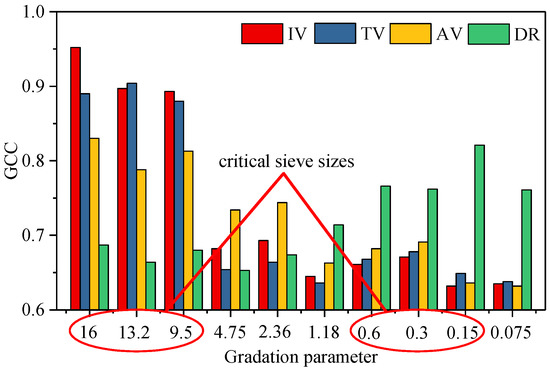
Figure 9.
GCC between gradation parameters and skid-resistance indicators.
In terms of IV, TV, and AV, the impact of the sieve passing rate with sizes of 16 mm, 13.2 mm, and 9.5 mm on the skid-resistance indicators account for the top three factors, meaning the sieve passing rate with sizes of 16 mm, 13.2 mm, and 9.5 mm have a great effect on these three skid-resistance indicators. In particular, the GCC between the sieve passing rate of these sizes and the two indicators (IV and TV) is around 0.9, indicating a strong correlation between them. In addition, the top three gradation parameters that have the greatest impact on the skid-resistance indicator DR are in the order: sieve size 0.15 mm > sieve size 0.6 mm > sieve size 0.3 mm. It can be concluded that the passing rate of these critical sieve sizes (16 mm, 13.2 mm, 9.5 mm, 0.6 mm, 0.3 mm, and 0.15 mm) should be controlled in order to improve the skid resistance of asphalt pavement.
4. Conclusions
This paper investigated the skid resistance of asphalt pavement incorporating different material compositions after various abrasions. Simultaneously, the GRA was used to qualitatively analyze the influence of aggregate types and gradation types on skid resistance. The following conclusions can be drawn:
- (1)
- With increasing abrasion cycles, the skid resistance of asphalt pavement firstly decreases rapidly in the first abrasion stage (0–8000 cycles), then at a relatively gentle rate in the second abrasion stage (8000–20,000 cycles), and finally at the lowest rate in the third abrasion stage (after 20,000 cycles).
- (2)
- The skid-resistance durability and stability of pavement are ranked as basalt > granite > amphibolite > limestone. Moreover, the effect of aggregate parameters on skid resistance is in the order: angularity > PSV > WSV > CSV. It can be concluded that the pavement with high angularity and PSV has a rich surface texture, resulting in high skid resistance.
- (3)
- AC-16 has the largest BPN TV and the smallest DR. In contrast, AC-10 has the smallest BPN TV and the largest DR. It indicates that the skid resistance and its stability improve as NMAS increases.
- (4)
- As the number of abrasions increases, the skid resistance of AC pavement is the first to fail, followed by OGFC pavement and SMA pavement.
- (5)
- The sizes of 16 mm, 13.2 mm, 9.5 mm, 0.6 mm, 0.3 mm, and 0.15 mm are the critical sieve sizes to improve the skid resistance of asphalt pavement. However, the effect of changes in these sieve sizes in the same mixture on skid resistance requires further investigation.
Author Contributions
Conceptualization, L.Q. and Y.L.; methodology, Y.L.; validation, L.Q., Y.L. and Z.L.; formal analysis, L.Q.; investigation, C.Z.; resources, Z.C.; data curation, H.W.; writing—original draft preparation, C.Z.; writing—review and editing, L.Q. and Y.L.; visualization, J.L.; supervision, J.L.; project administration, H.W.; funding acquisition, Y.L. All authors have read and agreed to the published version of the manuscript.
Funding
This study was supported by the National Natural Science Foundation of China (No. 51608048), the Natural Science Foundation of Shaanxi Province (No. 2020JM-247), the Transportation Science and Technology Project of Shandong Province (No. 2021B95), and the research project of Transportation Department of Fujian Province of China (No. 202236), Transportation Technology Project of Shandong Province (No.2021B20).
Institutional Review Board Statement
Not applicable.
Informed Consent Statement
Not applicable.
Data Availability Statement
Not applicable.
Conflicts of Interest
The authors declare no conflict of interest.
References
- Larson, R.M.; Scofield, L.; Sorenson, J. Pavement functional surface characteristics. Measurement 2004, 3, 4. [Google Scholar]
- Ning, B. Research on the Decay Law of Asphalt Pavement Antislip Performance and Repair Technology. Master’s Thesis, Chongqing Jiaotong University, Chongqing, China, 2018. [Google Scholar]
- Yang, Z.; Guo, Z. Research on accelerated test method of antislip performance of asphalt concrete antislip wear layer. East China Highw. 2002, 25, 50–54. [Google Scholar]
- Li, D. Study on the Antislip Performance of Asphalt Pavement Based on Rubbing Test. Master’s Thesis, South China University of Technology, Guangzhou, China, 2013. [Google Scholar]
- Huang, Y.; Shao, L.; Liu, Z. Study of asphalt pavement skid resistance test. Highw. Traffic Technol. 2002, 19, 5–8. [Google Scholar] [CrossRef]
- Masad, E.; Rezaei, A.; Chowdhury, A.; Harris, P. Predicting Asphalt Mixture Skid Resistance Based on Aggregate Characteristics Report No. FHWA/TX-09/0-5627-1; Federal Highway Administration (FHWA): Washington, DC, USA, 2009. [Google Scholar] [CrossRef]
- Ali, G.A.; Al-Mahrooqi, R.; Al-Mammari, M.; Al-Hinai, N.; Taha, R. Measurement, analysis, evaluation, and restoration of skid resistance on streets of Muscat. Transp. Res. Rec. 1999, 1655, 200–210. [Google Scholar] [CrossRef]
- Zhang, X.; Liu, T.; Liu, C.; Chen, Z. Research on skid resistance of asphalt pavement based on three-dimensional laser-scanning technology and pressure-sensitive film. Constr. Building. Mater. 2014, 69, 49–59. [Google Scholar] [CrossRef]
- Dahir, S.H.; Henry, J.J. Alternatives for the Optimization of Aggregate and Pavement Properties Related to Friction and Wear Resistance Report No. FHWA-RD-78-209; Federal Highway Administration (FHWA): Washington, DC, USA, 1978. [Google Scholar]
- Shah, S.M.R.; Abdullah, M.E. Effect of aggregate shape on skid resistance of compacted hot mix asphalt (HMA). In Proceedings of the 2010 Second International Conference on Computer and Network Technology, Bangkok, Thailand, 23–25 April 2010; pp. 421–425. [Google Scholar] [CrossRef]
- Sengoz, B.; Onsori, A.; Topal, A. Effect of aggregate shape on the surface properties of flexible pavement. KSCE J. Civ. Eng. 2014, 18, 1364–1371. [Google Scholar] [CrossRef]
- Bessa, I.S.; Branco, V.T.F.C.; Soares, J.B.; Neto, J.A.N. Aggregate shape properties and their influence on the behavior of hot-mix asphalt. J. Mater. Civ. Eng. 2015, 27, 04014212. [Google Scholar] [CrossRef]
- Kogbara, R.B.; Masad, E.A.; Kassem, E.; Scarpas, A.; Anupam, K. A state-of-the-art review of parameters influencing measurement and modeling of skid resistance of asphalt pavements. Constr. Build. Mater. 2016, 114, 602–617. [Google Scholar] [CrossRef]
- Hall, J.W.; Smith, K.L.; Titus-Glover, L.; Wamblod, J.C.; Yage, Z. Guide for Pavement Friction Contractor’s Final Report for National Cooperative Highway Research Program (NCHRP) Project 01-43; Transportation Research Board of the National Academies: Washington, DC, USA, 2009. [Google Scholar]
- Ongel, A.; Lu, Q.; Harvey, J. Frictional properties of asphalt concrete mixes. Proc. Inst. Civ. Eng. Transp. 2009, 162, 19–26. [Google Scholar] [CrossRef]
- Pomoni, M.; Plati, C.; Loizos, A. How can sustainable materials in road construction contribute to vehicles’ braking? Vehicles 2020, 2, 55–74. [Google Scholar] [CrossRef]
- Pomoni, M.; Plati, C. Skid resistance performance of asphalt mixtures containing recycled pavement materials under simulated weather conditions. Recycling 2022, 7, 47. [Google Scholar] [CrossRef]
- Asi, I.M. Evaluating skid resistance of different asphalt concrete mixes. Build. Environ. 2005, 42, 325–329. [Google Scholar] [CrossRef]
- JTG F40-2019; Technical Specification for Construction of Highway Asphalt Pavement. Ministry of Transport of the People’s Republic of China: Beijing, China, 2019.
- JTG E42-2005; Test Methods of aggregate for Highway Engineering. Ministry of Transport of the People’s Republic of China: Beijing, China, 2005.
- Ren, W.; Han, S.; Ji, J.; Wang, Z.; Wang, J. Laboratory evaluation method of tire-pavement noise deterioration combining Rolling Tire down Tester with accelerated abrasion machine. Measurement 2022, 202, 111831. [Google Scholar] [CrossRef]
- Ren, W.; Han, S.; He, Z.; Li, J.; Wu, S. Development and testing of a multivariable accelerated abrasion machine to characterize the polishing wear of pavement by tires. Surf. Topogr. Metrol. Prop. 2019, 7, 035006. [Google Scholar] [CrossRef]
- JTG 3450-2019; Field Test Methods of Highway Subgrade and Pavement. Ministry of Transport of the People’s Republic of China: Beijing, China, 2019.
- Xu, J.; Gong, Y.; Chen, L.B.; Ma, T. High-Temperature Performance of Asphalt Mixtures: Preliminary Analysis for the Standard Technical Index Based on Gray Relational Analysis Method. Adv. Mater. Sci. Eng. 2020, 2020, 5818036. [Google Scholar] [CrossRef]
- Wang, X.; Zhao, J.; Li, Q.; Fang, N.; Wang, P.; Ding, L.; Li, S. A Hybrid Model for Prediction in Asphalt Pavement Performance Based on Support Vector Machine and Grey Relation Analysis. J. Adv. Transp. 2020, 2020, 7534970. [Google Scholar] [CrossRef]
- Yin, L.; Wang, Y.; Yu, T.; Zhang, H.; Wang, H.; Chen, C. Study on micromechanisms of macro evaluation indexes for asphalt based on grey relation analysis. Int. J. Pavement Eng. 2022, 23, 5186–5197. [Google Scholar] [CrossRef]
- Zheng, C.; Liu, R.; Hu, M.; Zou, L. Determination of low-temperature crack control parameter of binding asphalt materials based on gray correlation analysis. Constr. Build. Mater. 2019, 217, 226–233. [Google Scholar] [CrossRef]
Disclaimer/Publisher’s Note: The statements, opinions and data contained in all publications are solely those of the individual author(s) and contributor(s) and not of MDPI and/or the editor(s). MDPI and/or the editor(s) disclaim responsibility for any injury to people or property resulting from any ideas, methods, instructions or products referred to in the content. |
© 2023 by the authors. Licensee MDPI, Basel, Switzerland. This article is an open access article distributed under the terms and conditions of the Creative Commons Attribution (CC BY) license (https://creativecommons.org/licenses/by/4.0/).